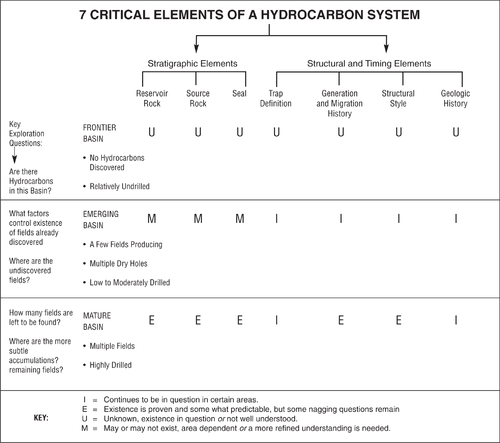Hydrocarbon accumulation: the seven critical elements
| Exploring for Oil and Gas Traps | |

| |
| Series | Treatise in Petroleum Geology |
|---|---|
| Part | Predicting the occurrence of oil and gas traps |
| Chapter | Value of geological fieldwork |
| Author | Denise M. Stone |
| Link | Web page |
| Store | AAPG Store |
Seven critical elements are necessary for subsurface hydrocarbon accumulations to occur:
- Reservoir rock
- Source rock
- Seal
- Thermal history
- Migration and trapping of hydrocarbons
- Geologic history of the basin
- Structural history and style
Criticality
Exploration risk is best understood by studying historically what has and has not been successful in a basin. In other words, what combination of the seven critical elements occurred to form existing fields and, conversely, what are the main reasons for the dry holes in that same basin? Is a common element responsible for the dry holes?
The goal of an exploration effort is to use all the data available to identify fully the technical risks and recommend the best course of action and investment. Action following a field project might range from no action, to acquiring more data in key areas, to drilling a well.
Critical element checklist
The following checklist summarizes key attributes of the seven critical elements. The working explorer should have a general understanding of these attributes in the basin studied.
Reservoir rock
General 3-D definition
- Sedimentary rock type(s)
- Gross thickness range
- Lateral continuity (faulted?)
- Mappability
- Depth of burial
- Structural relief of reservoir top
- Outcrop occurrences
Character of upper and lower boundaries
- Origin: erosional vs. depositional
- Nature: abrupt vs. gradational
- Seismic reflectivity
- Conformability
Diagnostic features
- Depositional environment
- Facies distribution
- Provenance
- Internal stratigraphic subdivisions
- Age diagnostic criteria: fossils, intrusives, marker horizons
- Electric log responses
- Pay distribution: vertical, lateral
- Sedimentary structures
Petrographic characteristics
- Composition: framework grain mineralogy, crystallinity
- Texture: grain size, sorting, roundness, crystallinity
- Degree of cementation
- Diagenetic alteration
- Microfossils
- Fractures
- Porosity
- Permeability
Source rock
- Age
- Thickness
- Lateral continuity
- Organic richness
- Thermal maturity
- Kerogen type
- Depositional environment
- Facies
- Mappability
- Carbonate vs. clastic
- Depth of burial
Seal
- Vertical seals
- Lateral seals
- Lithology of potential seals
- Capillary pressure
- Lateral continuity of sealing formations
- Presence of evaporites
- Fracture systems
Thermal history
- Rates of deposition
- Rates of burial
- Paleogeothermal gradient
- Tectonic history
- Location of kitchen areas
Migration and trapping
- Fault juxtaposition
- Fractures
- Lateral permeability and porosity
- Controls on migration
Geologic history
- Main tectonic events: compressional, tensional, wrench
- Structural overprinting
- Depositional history: continental, marine
- Episodes of subsidence: regional, local
- Controls on subsidence
- Unconformities
- Significant episodes of volcanism, subsidence, uplift, erosion
- Rates of deposition
- Paleotopography
- Paleoclimate
- Chronostratigraphy
Structural history and style
- Compressional vs. tensional basin
- Main structural elements
- Tectonic development
- Sequence of events
- Structural overprinting
- Fault trends: major and minor
- Basin boundary faults
- Major faults vs. minor faults
- Zones of weakness
- Dip domains
- Outcrop patterns
- Dip and strike trends
- Average throw on faults
